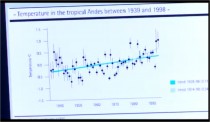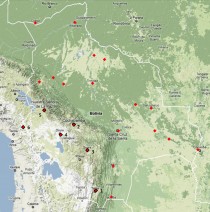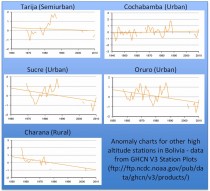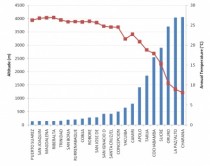By Verity Jones, Digging in the Clay
Last week the Guardian published an article reporting from Bolivia on plans to introduce new laws:
Bolivia is set to pass the world’s first laws granting all nature equal rights to humans. The Law of Mother Earth, now agreed by politicians and grassroots social groups, redefines the country’s rich mineral deposits as “blessings” and is expected to lead to radical new conservation and social measures to reduce pollution and control industry.
This is Bolivia setting itself up as a victim of climate change and, as such, at the mercy of Western economies, demanding large cuts in carbon emissions at the UN climate talks.
Bolivians are living with the effects of climate change every day...Bolivia is struggling to cope with rising temperatures, melting glaciers and more extreme weather events including more frequent floods, droughts, frosts and mudslides.
Research by glaciologist Edson Ramirez of San Andres University in the capital city, La Paz, suggests temperatures have been rising steadily for 60 years and started to accelerate in 1979. They are now on course to rise a further 3.5-4C over the next 100 years. This would turn much of Bolivia into a desert.
These issues were also discussed in an accompanying video report. This is a screenshot of the graph shown by Ramirez (enlarged here):

According to the trends used here warming for the period 1974-1998 was 0.34 deg.C per decade (paler blue line) (3.4 deg.C per century).
How much of a temperature rise?
Ramirez says 3.4C per century. And the graph appears to stop in 1998. Hmm. One of the issues raised previously for this part of the world was the lack of data reported from Bolivia into the climate data sets, with no stations in GHCN V2.mean and GISTEMP after 1990 (see E.M. Smith’s The Bolivia Effect).
GHCN V3, released in September and still in ‘Beta’ testing, has at least 18 stations with data in 2009/10. Here’s the data for La Paz/Alto (enlarged):

Top Panel: Unadjusted Data (L-R) Months x Years; key for monthly data; Unadj anomaly plot. Lower Panel: Adjusted Data (L-R) Months x Years; key for monthly data; Adjusted anomaly plot.
The adjusted data, corrected for instrumental changes and station moves etc. shows the warming he was talking about, and its acceleration after 1979, but he neglects to mention that more recent data shows a drop of around 1.5C, falling back to the level of 1940-1980. Oh dear - another case of hiding the decline But that’s just La Paz/Alto. It is a large city that has been rapidly growing, particularly El Alto, surrounding the airport. In fact from another article by the Guardian’s John Vidal explains the growth of the city that has surrounded the airport and weather station (possibly contributing to the temperature rise):
Poor El Alto is the satellite city of rich La Paz, overlooking the capital of Bolivia from up in the altiplano. In 1952 it was little more than a village; in 1960 it had fewer than 30,000 people; now it has exploded into a metropolis with up to 1 million or more…
La Paz / Alto from Google Earth, showing location of weather station according to GHCN. Marker from Google Earth KML files available here. (see also)
So what of other stations?
Bolivia is a country with distinct climate zones - basically lowland tropical/seasonal and high altitude cold/semi arid.
Five stations besides La Paz/Alto are high altitude. The following map shows not only the stations, but also the terrain:

GHCN V3 Stations in Bolivia.
High altitude stations are: 1. Tarija 1854m; 2. Cochabamba 2548m; 3. Sucre 2903m; 4. Oruro 3702m; 5. La Paz/Alto 4038m; 6. Charana 4054m. Background map from Google.
Other than La Paz/Alta, the five high altitude stations where a trend is derived show no sign of catastrophic warming when data after 2000 are taken into account. In fact it is quite the opposite, and more than that, presenting the data only up to 1998 was a convenient cherrypick.

Enlarged here.
Of lowland stations, seven (Cobija (R), Riberalta (R), San Ignacio D (R), Santa Cruz/El (U), San Jose De (R), Puerto Suarez (R) and Yacuiba (R)) show a warming trend, which seems to be greatest for those towns with highest population growth (note that looking on Google Earth, many seem far from rural); San Joaquin (R) and Rurrenabaque (R) are dead flat, and the remaining six (Concepcion, (R) Magdalena (R), San Borija (R), Trinidad (S), Robore (R) and Camiri (R)) have a strong cooling trend. Overall, there appears to be no rising temperature crisis in Bolivia.
Vidal’s second article does give something away:
Hundreds of thousands of people have flooded in from the countryside to find work and opportunity, but increasingly the reason they give for moving is that frequent droughts, erratic rainfall, heatwaves, unseasonal frosts and floods have made conditions too hard to grow crops. Bolivia has had five major droughts or heatwaves, as well as floods and major mudslides in the past decade. Few people in El Alto could be classed entirely as “climate refugees”, but the changing physical environment is clearly one of the new drivers of people to this burgeoning city.
I have huge sympathies for people in developing nations who rely on subsistance farming and natural supplies of water, and the loss of Andean glaciers is indeed a concern for the region, however, this kind of reporting does no-one any favours.
See full report and links to city data in the excellent investigative report.
Hockey Schtick
The anthropogenic global warming theory is based upon the notion that increasing ‘greenhouse gases’ will increase infrared ‘back-radiation’ to the earth to [supposedly] warm the planet. The theory also claims that increases in the minor ‘greenhouse gas’ carbon dioxide will cause increases in the major ‘greenhouse gas’ water vapor to amplify the infrared ‘back-radiation’ and global warming. A study published online yesterday in The Journal of Climate, however, finds that contrary to the global warming theory, infrared ‘back-radiation’ from greenhouse gases has declined over the past 14 years in the US Southern Great Plains in winter, summer, and autumn. If the anthropogenic global warming theory was correct, the infrared ‘back-radiation’ should have instead increased year-round over the past 14 years along with the steady rise in atmospheric carbon dioxide.
Long-Term Trends in Downwelling Spectral Infrared Radiance over the U.S. Southern Great Plains
Journal of Climate
P. Jonathan Gero, Space Science and Engineering Center, University of Wisconsin-Madison, Madison, Wisconsin
David D. Turner, NOAA / National Severe Storms Laboratory, Norman, Oklahoma and Department of Atmospheric and Oceanic Sciences, University of Wisconsin-Madison, Madison, Wisconsin
Abstract: A trend analysis was applied to a 14-year time series of downwelling spectral infrared radiance observations from the Atmospheric Emitted Radiance Interferometer (AERI) located at the Atmospheric Radiation Measurement (ARM) site in the U.S. Southern Great Plains. The highly accurate calibration of the AERI instrument, performed every 10 minutes, ensures that any statistically significant trend in the observed data over this time can be attributed to changes in the atmospheric properties and composition, and not to changes in the sensitivity or responsivity of the instrument. The measured infrared spectra, numbering over 800,000, were classified as clear-sky, thin cloud, and thick cloud scenes using a neural network method. The AERI data record demonstrates that the downwelling infrared radiance is decreasing over this 14-year time period in the winter, summer, and autumn seasons but is increasing in the spring; these trends are statistically significant and are primarily due to long-term change in the cloudiness above the site.
The AERI data also show many statistically significant trends on annual, seasonal, and diurnal time scales, with different trend signatures identified in the separate scene classifications. Given the decadal time span of the dataset, effects from natural variability should be considered in drawing broader conclusions. Nevertheless, this data set has high value due to the ability to infer possible mechanisms for any trends from the observations themselves, and to test the performance of climate models.
See post here.
By Chris Horner, the Daily Caller
Lee Casey and David Rivkin had a piece in yesterday’s Wall Street Journal, “Climate Change heads to the Supreme Court.” The subhead - “Green activists hope to force electric utilities and many others to pay ‘public nuisance’ claims for emitting carbon dioxide” - sets forth the basics of the case, which will be argued Tuesday to determine whether courts can assign individual liability for individual contributions to climate change (really), on the grounds of common law nuisance.
There are several cases in the federal judicial circuits confronting similar claims, from utilities causing or contributing to global warming to oil companies causing or making Hurricane Katrina worse. Imagine if this practice is unleashed.
The Casey/Rivkin piece hits the right notes but also provides context for the next few days’ worth of marches, stories, human interest items and editorials in the establishment press. For example, Washington is presently being swarmed for four days by Al Gore, Van Jones and the left-liberal greenosphere.
History also suggests that there will be media activism in the coming days. In “Red Hot Lies” I detail this practice, opening with when SCOTUS argument loomed in 2006 in another global warming case, Massachusetts v. EPA. The Washington Post “hurled a three-pronged assault of brow-furrowing at the Supreme Court in the days before argument in the important Massachusetts v. EPA case, including heart-wrenching tales of ski resorts in peril,” and an op-ed by Al Gore’s cinematic collaborator Laurie David. The Post also published an unsigned editorial warning the justices that the Georgetown cocktail set was watching them closely on this one and would sure hate to get mean about things.
Whatever their impact on this 5-4 opinion (in which I and two colleagues represented the “skeptic” scientists in their amicus brief to the Court), that case directly led to the extant, looming regulatory train wreck of EPA trying to seize economic regulatory authority through an administrative version of the failed cap-and-trade legislation.
That scheme is so bad that even Sen. Barbara Boxer (D-CA) expressly cited it as a threat to regulated interests that were insufficiently rolling over and accepting cap and trade.
We have the slim Mass. v. EPA majority to thank for that unfolding disaster. They revised the Clean Air Act from how it was written and interpreted for 35 years into a vehicle for ideologues in their push to “fundamentally transform America.”
With next week’s case, things could get worse. Yet the administration is taking a curious line in Tuesday’s argument. It is arguing the substance, but has declined to address whether the “political question” doctrine assigns responsibility for this matter to the political branches. Laurence Tribe, of all people, made a compelling case that, under our Constitution, global warming-related issues should be decided by the political branches. That is, until by order of the Obama administration, he didn’t.
Team Obama wants the Court to step aside in this particular mess, arguing in essence that we’re handling it, but they don’t want a ruling that will impede the trial bar and activist courts from interfering in future cases should the EPA enterprise go down in flames. They want the Court only to rule that Congress has addressed this, as five justices ruled the Clean Air Act is really a global warming regime, and EPA is proceeding on the authority we conjured from the emanations and penumbras of that law
Their reasoning is transparent and alarming. The administration wants to hold the threat of a global warming industry over the heads of Congress and the regulated economy, to coerce them into folding up their resistance against EPA’s backdoor power grab. The administration seems to believe that, without such threats to get the productive sector of the economy to surrender and settle, it cannot enshrine any such regime politically. That’s instructive.
It is also the sort of cynicism and abuse of government and power we have come to expect from the left-liberals - the environmentalists specifically - and the Obama administration. But that by no means makes it right.
So next week’s case is of extreme importance. As Justice Scalia indicated in his enlightening Mass. v. EPA dissent, we always face the prospect of five justices who want a particular outcome and will labor to get there. As he concluded:
The Court’s alarm over global warming may or may not be justified, but it ought not distort the outcome of this litigation...No matter how important the underlying policy issues at stake, this Court has no business substituting its own desired outcome for the reasoned judgment of the responsible agency.
But here you see the reason for media activism and enviro acting-out in coming days. Remember that when you hear the noise machine cranking up. It’s only an attempt to pressure the judiciary. Read post here.
Chris Horner is a senior fellow at The Competitive Enterprise Institute.



